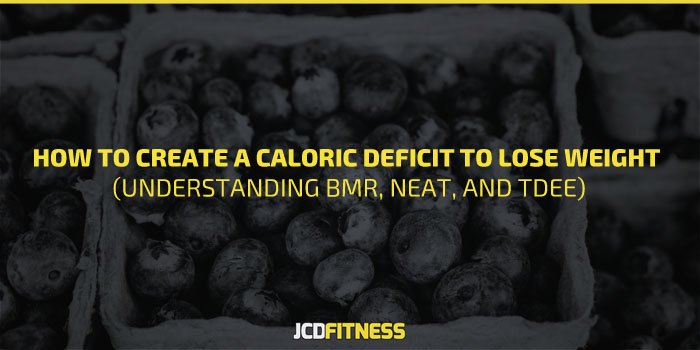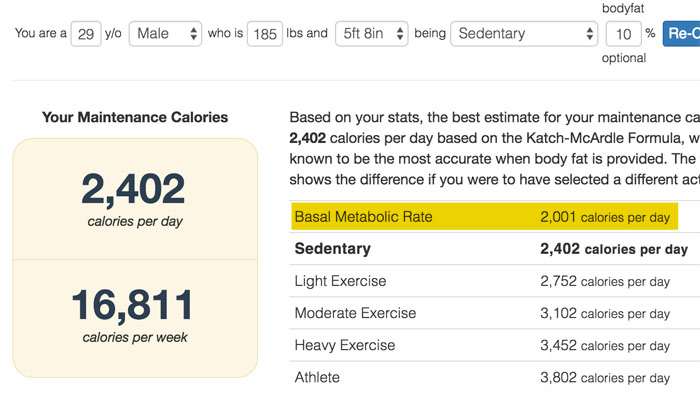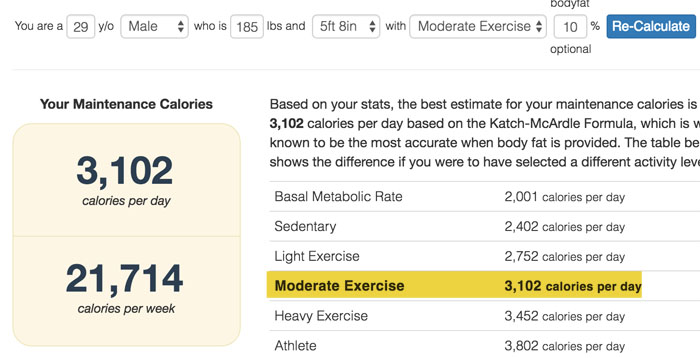Once you’re finished reading this short article, you will understand exactly how to create a caloric deficit to lose weight by understanding your BMR (basal metabolic rate), your TDEE (total daily energy expenditure) and NEAT (non-exercise activity thermogenesis).
Every so often, we get some questions here that deserve a short explanation for everyone to benefit. The question email to me was the following…
“How do you burn more calories than what you consume? I eat about 1200 calories per day. To create a deficit, I have to burn more than 1200. How can I do that? I go to the gym, workout for an hour or so, and burn about 500-600 calories. After that, my activity level drops because I have a desk job. So how do I burn another 700-800 calories?”
To put this in perspective, the person writing this email was a smaller woman with a sedentary job who is exercising 3 times per week at the gym. So her overall expenditure is going to be lower than someone with an active job and training weekly at the gym.
How To Create A Caloric Deficit
The short answer is to eat less than you burn on a daily basis and continue this pattern to force your body to burn energy from stored body fat. While it’s a simple statement, it’s not always the easiest to implement due to a misunderstanding of how calories are used by the body for repair and energy production.
Creating a caloric deficit is not just eating healthy foods or clean eating. In this article, you’ll quickly learn about how to estimate your energy expenditure and create the caloric deficit based on how much your body’s burning on a daily basis through bodily functions (keeping you alive) and additional exercise.
What Determines Your Total Energy Expenditure?
There are 3 variables to become aware of to fully understand how a caloric deficit is created.
Those are:
- BMR (basal metabolic rate)
- TDEE (total daily energy expenditure)
- NEAT (non-exercise activity thermogenesis)
Basal Metabolic Rate (BMR) is what you burn at rest. It’s what you’d burn every day, no matter what to keep your body functioning and alive. Think of it like this… if you were to stay in bed all day doing nothing, your body would still require a certain amount of energy needed for function.
We tend to equate our activities such as training, cardio, walking around as what burns calories. And while those activities do burn calories, our bodies are also burning calories just to stay alive. All of your organs require energy from food to function normally.
Your brain requires glucose for processing power. Your stomach requires calories to digest food, which it turns into useable energy for later. Your heart requires energy to keep beating. Your skin and bones require energy to repair themselves from everyday cell turnover (cell replication).
For ease of explanation, I input some numbers into this calculator to help illustrate how this works.
As you see below, you have the inputs for height, weight, and activity level (I chose sedentary for sake of the question above).

From here, you know that for a male at 185 pounds, he’ll be burning roughly 2000 calories per day just to survive. Our bodies are warm and as a result, they require a good amount of energy just to function on a daily basis.
Let’s next look at the activity on top of your BMR.
Total Daily Energy Expenditure (TDEE) is your BMR plus all the other energy expended outside of what it takes to keep your body functioning. This includes moving around for daily tasks (getting out of bed, brushing your teeth, walking around your house, making food, going to work, training at the gym, playing frisbee in the park, etc).
All of that extra activity requires calories for energy. As a result, your total energy requirements go up. Let’s say that you’re training 3-4 days per week with weights. As you’ll see by the example below, your daily requirements for calories (TDEE) goes up a good amount in relation to your BMR.
TDEE is also sometimes referred to as your maintenance intake, which is exactly what it sounds like: what it takes in terms of calorie intake to maintain your body weight, all activity included.
A common concern of many (myself included) is whether or not these activity calculators are 100% correct for every individual. The truth is they’re not. Sometimes your expenditure may not be in line exactly with the total amount of energy suggested to maintain your body weight.
So instead of taking these calculators as a defining measure of how much you need to consume on a daily basis, it’s better to see them as a starting point from which you can adjust over time based on your real world results.
If you eat according to the maintenance caloric level suggestions and you lose weight, you’ll need to eat more. If you gain weight on the calculator’s recommendations, you’ll need to eat less.
So what gives in terms of the accuracy or inaccuracy of these calculators for everyone? There are 2 variables:
- Tracking your nutrition accurately
- NEAT
I’ve already covered how to track macros in the past. Give that article a read if you want to know all about that.
Non-Exercise Activity Thermogenesis (NEAT) is energy expended for everything we do that is not sleeping, eating or sports-like exercise. NEAT can differ wildly from person to person. You might have 2 people who are seemingly identical in their daily habits, exercise intensity, muscular build, and eating habits but have differing levels of energy requirements.
Outside of some slight metabolic differences, the amount of food they need to maintain their weight will often be affected by their NEAT. Some people are generally more fidgety than others. Some tap their foot during work, while others hardly move at all.
Some find it incredibly hard to sit still, and others can be perfectly fine vegging out on the couch all day. NEAT can have a drastic impact on your energy expenditure when it doesn’t outright negatively affect your daily routine.
For instance, the person who walks to work, or spends time getting up at regular intervals from their desk to stretch and move around are going to burn more calories from these activities than someone who drives to work and is chained to their desk.
This is why people with active jobs (people on their feet all day, those with delivery routes, doing manual labor) can seem to be bottomless pits when it comes to their food intake.
So How Do You Create A Caloric Deficit To Lose Weight?
The short answer is to consume fewer calories than you burn on a daily basis. But the process of creating the deficit needs a little clarification.
Let’s look at her question once more:
I eat about 1200 calories per day. To create a deficit, I have to burn more than 1200. How can I do that? I go to the gym, workout for an hour or so, and burn about 500-600 calories. After that, my activity level drops because I have a desk job. So how do I burn another 700-800 calories?”
As you’ll see, she was confusing the amount of food she was eating (total caloric intake) with her daily expenditure. In this case, her BMR is already likely higher than the 1200 calories she was consuming.
But for the sake of numbers, let’s assume her BMR was equal to 1200 calories. (This is purely for example purposes).
She’s already consuming 1200 calories. Her daily activity, along with her training during the day would contribute to her TDEE, which could be upwards of 1800 or more calories depending on her body weight.
So if she’s consuming only 1200 calories but expending 1800 or more calories, she’s already put herself in a caloric deficit of 600 calories due to her daily expenditure and exercise habits.
In my how to lose weight article, I outline the process as follows:
What Causes Fat Loss?
Negative (-) energy balance, plain and simple.
Energy in (eating food), energy out (expenditure), and your unique maintenance-level intake are all factors in what actually makes you lose fat.
To put it simply, all you need to lose weight (hopefully mostly from fat) is a calorie deficit. This means by the end of the day (or week, or month on a longer timeline), you’re in a negative energy balance. You’re burning more than you’re ingesting.
Simple math: If you burn 2500 calories in a 24-hour period, and only consume 2000 calories, you’re in a 500 calorie deficit. So, that energy is going to come from somewhere. Your body, if you do this correctly, will use its reserves (either stored glycogen or body fat).
How your body determines where to obtain the energy from is a very complex process. You have three forms of energy it can pull from, either protein (ingested or in the form of lean body mass, a.k.a. muscle), fat (the stuff on your tummy, and butt) or stored carbohydrates (glycogen) in the muscles/liver.
Of course, through diet, and training, we try to influence the body to burn mostly fat when we go on a restricted diet, but this is not in our control 100% of the time.
To get the full explanation on how to lose fat, make sure you give How To Lose Weight: The Best Way To Lose Fat, and Avoid Fad Diets a read.
Practical Application Of Creating The Caloric Deficit
Losing fat takes time, so it makes sense to lose body fat in a progressive manner, instead of trying to lose it rapidly. Using the example I’ve provided above, if you were to create a daily 500 calorie deficit, you’d be at a deficit of 3,500 calories by the end of the week.
For most people, this should equate to roughly 1 pound of fat loss per week. However, you might not lose exactly 1 pound in scale weight due to water fluctuations, bowel movements (or lack thereof), or your hydration levels.
Is it okay to create a bigger deficit?
For some people, it will be okay, but not forever. In general, the heavier you are, and the more weight you have to lose, the bigger of a deficit you can create. However, the leaner you are, and the leaner you get, the deficit cannot be as big for 2 reasons:
- You risk muscle loss
- It’s harder to create a deficit for leaner people because they’re generally smaller, and burn fewer calories based on their body weight.
So when you’re focusing on fat loss, I think the following methods of measurement are ideal:
- Once weekly tape measurements (waist, hips, chest) at the same time and same conditions (always do it in the morning before eating, and after urinating).
- Progress pictures once every 2 weeks to have comparison photos.
- Scale weight averages over the week. Instead of jumping on the scale once per week, it’s better to get an average of 3-4 days because of how much your body weight can fluctuate within a day. Always weigh at the same time, under the same conditions and chart progress.
Creating a caloric deficit is a fairly easy endeavor, but there are some things you should pay attention to if you want to get the most out of the process.
- Eat enough protein. In my article about how much protein you need, I discuss the total amount you probably should be eating on a daily basis, and no, it’s not an absurdly high amount. Eating enough protein will ensure you maintain your muscle.
- Don’t eliminate the carbohydrates. Carbohydrates are essential for your long-term health, regardless of what some gurus might tell you. Check out these articles: Is sugar bad for you and will it make you fat? and If you want to lose fat and keep it off, don’t fall for the low-carb trap.
- Don’t rely too much on calorie counts from wristbands, fancy arm gadgets, heart rate monitors, or even exercise machines (like treadmills, rowers, or ellipticals). My friend Dick Talens wrote a good article about this so-called Quantified Self movement.
- Train with weights on a consistent basis to maintain your muscle tissue. Some articles worth reading: Weight training for women, hypertrophy training, how to train properly for fat loss, and training for fat loss.
- Limit cardio training as much as you can to ensure recovery.




Here is a question when you go in taking in less calories than you burn, your metabolism slows down. A simple calorie reduction does not equate to fat loss. Any suggestions in how you can trick your body you are not trying to starve it?
good question. However, you don’t get a loss in metabolism immediately after lowering your calories. My suggestions are to employ refeeds and diet breaks as necessary. I’ve written about this before. I need to get a good search function.